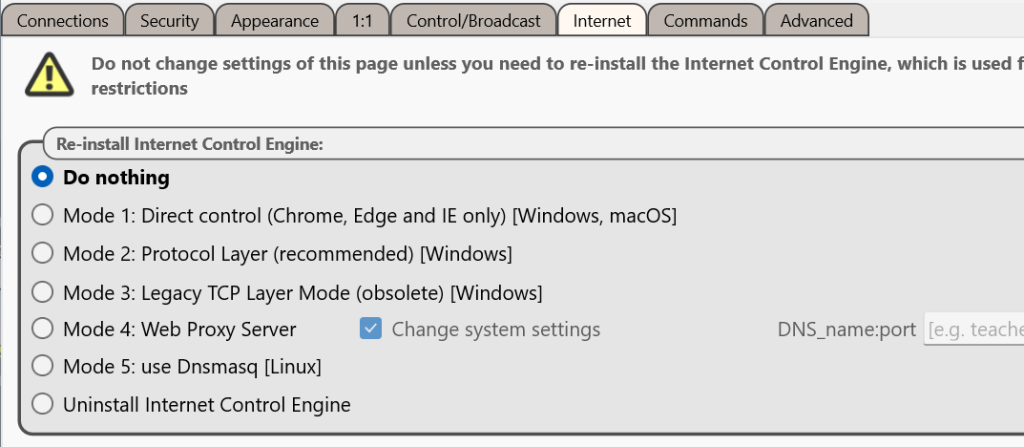Internet Control Engine (ICE) is a subsystem in Net Control 2 software that is responsible for execution of Internet restrictions: preventing access to undesirable websites.
The implementation of ICE depends on the operating system used on student computers.
In Windows or macOS operating systems, most often you do not need to configure or modify Internet Control Engine settings, unless Internet restrictions do not work for some reason.
In Linux, Internet Control Engine should be specially configured in order to apply Internet restrictions. Such configuration should be done only once.
In all cases, to modify ICE settings, you need to select student computers in the teacher console, then click the main menu command of the teacher console N → Options → Client Options. ICE settings you can find on the Internet tab of the settings window. You can also modify the settings on each student computer individually: open the student console, then click the Configure button in the bottom-right hand corner of the student console window, open the Internet tab.
Windows
In Windows, ICE supports modes 1 – 4. The default and recommended mode is Mode 2:

In Mode 1, Net Control 2 service repeatedly checks the currently opened tab of Chrome, Edge or Internet Explorer browsers, and if a blocked website is visited, the software immediately closes the tab or the entire browser. This assumes that the blocked content still may be visible for a short period of time, e.g. about one second; the browser may be closed when a student just begin typing the blocked website’s name.
Modes 2 and 3 work with DNS queries sent in browsers. Mode 2 supports Brave, Chrome, Edge, Firefox, Internet Explorer, Opera, Vivaldi and Yandex browsers. Custom browsers can be added manually when necessary, please contact us if you need to add a custom browser. Mode 2 is the default mode and is recommended in most situations. Chromium-based browsers released after 2023 (Chrome, Edge, Brave, Vivaldi, Yander) by default use special techniques, which prevent effective filtering of websites through local DNS services. Net Control 2 version 23.1 and higher can handle such situations. If you use an older version of Net Control 2 please refer the following article: Internet restrictions do not work (2023)
Mode 3 is maintained for compatibility purposes and is not recommended for common situations. The mode works on the protocol level, does not depend on a browser, but also does not support secure https connections or packed content, which is used by many modern websites.
Mode 4 is recommended for cases when Mode 2 cannot be used for some reasons. In this mode, the teacher module establishes a web proxy server, and students access web through this proxy, i.e. all web traffic is passed through the teacher computer, which provides necessary filtering, according to Internet restrictions. For more information please also see the article How to setup Web Proxy Server
macOS
The student module in macOS always supports Mode 1 by default
Linux
The student module in Linux operating systems supports Modes 4 and 5.
Like in Windows, in Mode 4 the teacher module establishes a web proxy server, and students access Internet through this proxy, i.e. all web traffic is passed through the teacher computer, which provides necessary filtering, according to Internet restrictions. This mode is simple in configuration and use and most often it does not interfere with the existing network environment or settings. Please also see here: How to setup Web Proxy Server
Mode 5 uses dnsmasq service that should be installed on student computers separately. Dnsmasq is not a part of Net Control 2 software but a third party package for Linux distributives, available in most distributions. Read here, How to install dnsmasq on Linux



